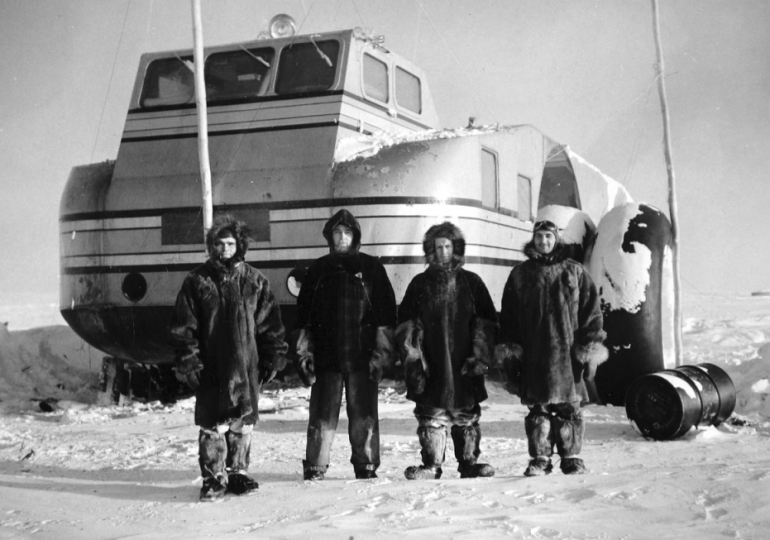OVER 70 years ago the ground-breaking Snow Cruiser was left abandoned in Antarctica – and to this day remains the continent’s biggest mystery.
The 37,000-tonne monster truck, designed to carry a team of elite explorers across 5,000 miles, was left to rot after scientists realised it wasn’t up to task.
United States Antarctic ServiceA team of elite explorers were supposed to make the perilous journey to Antarctica’s South Pole in the Snow Cruiser[/caption]
United States Antarctic ServiceThe 37,000 tonne machine was a self contained ‘lab on wheels’[/caption]
United States Antarctic ServiceIt was left abandoned in the snow in 1941 when researchers realised it wasn’t up to the might task[/caption]
US President Roosevelt put together an elite team of Antarctic explorers in 1939 who would be sent on a daring mission to the centre of Antarctica – the South Pole.
Before 1939, only two expedition teams had made it through the brutal conditions to get there – and only one had survived.
The 14 million square kilometres of ice fields and polar mountains combined with brutal temperatures meant explorers had struggled for years to investigate the mysterious land.
The temperatures in Antarctica can plummet to below -80C and winds travel at up to 300kph.
But in 1940, a team of five brave explorers had set off on a mission inside a cruiser – a 37,000 tone self-sufficient lab on wheels – for a year.
The ‘Penguin’, as it was known, would set off from the US base near the Ross Ice Shelf and plough through the ice while scientists inside collected data.
Explorers could sleep, study and eat inside the cruiser, all while covering 5,000 miles of ice.
The incredible machine cost $150,000 to build in the 1930s – which today looks more like £2.6million.
It was a feat of masterful engineering for it’s time – even decked out with its own airplane on the roof to conduct aerial surveys.
The four massive wheels driven by an early diesel-electric drivetrain could allow the cruiser to cross ice crevices up to 14ft wide at a speed of 30 miles per hour.
It came with space for the crew to sleep and work, with its own kitchen and spare supplies.
At the time America had one research base on the coast, but competition for the valuable oil and minerals buried under ice sheets on the enormous continent was fierce.
To establish a more prominent presence in the continent, the States have drawn out plans for what was to become one of America’s most ambitious expeditions.
In 1940, American explorers shipped the enormous cruiser to Antarctica to explore the South Pole, thousands of miles inland from their coastal research base on the Ross Ice Shelf.
Enormous crowds waved off the cruiser as it made its way from Chicago to Boston where it was to be transported by ship to Antarctica.
But heavy rain had proved a serious issue for the tank which was designed to plough through brutal terrain.
In an embarrassing twist, the cruiser became stuck in heavy mud on its journey to Boston for three days – causing one of the biggest traffic jams at the time.
When it finally reached the icy continent, the cruiser had encountered another mishap.
Having been built in only 11 weeks during summer, the Cruiser set its wheels on the snow for the first time in 1940.
The vehicle struggled to move through the brutal terrain – instead sinking further into the snow.
The team would later realise that the tires produced more traction when driven backwards.
And with enormous effort, the machine would be driven backwards for 92 miles until it was made into a research station.
In the face of World War Two, the explorers gave up on the now stationary research hub and returned home.
It was spotted again in 1946 needing just minor repairs to make it operational, but was used as a shelter before it was abandoned again.
It was found years later in 1958, buried under 23ft of snow where it had been left so many years before.
The inside of the enormous vehicle was even perfectly preserved, with research papers and cigarettes from the crew still strewn around the cabin.
But it would vanish once again for 66 years with its whereabouts still unknown.
In 2005, two dedicated researchers have made their guesses as to where the Snow Cruiser could be found.
According to their paper, at some point in 1962, the cruiser had separated from the Ross Ice Shelf and likely floated along the coastline.
From there, the ice carrying the machine would’ve slowly eroded, sending the cruiser to rest at the bottom of the Ocean floor.
So, the cruiser is still around somewhere 15-mile-wide area hiding underwater.
But most of the area is covered by ice, making it impossible to scan the waters.
Not all hope is lost though as researchers note that huge chunks of ice sometimes break off the shelf, making the area accessible.
While the exact location of the Snow Cruiser remains a mystery, this discovery gives scientists hope that it could one day be uncovered.
United States Antarctic ServiceThe Snow Cruiser was built in just 11 weeks during summer[/caption]
United States Antarctic ServiceCrew member T.A. Petras stands behind the Snow Cruiser on September 20, 1940[/caption]
United States Antarctic ServiceSergeant Felix Ferranto, radio operator, works with a primus torch to thaw out the wheel motors of the Snow Cruiser on August 23, 1940[/caption]
United States Antarctic ServiceThe Snow Cruiser covered in snow as it was abandoned[/caption]
Leave a comment








